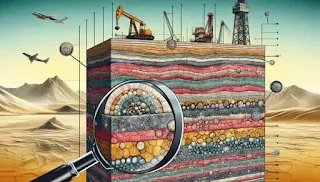Lecture about Porosity in Reservoir Rocks PPT
Understanding Porosity in Reservoir Rocks
Porosity is a critical rock property in the oil and gas industry. It defines the fraction of a rock’s volume that is occupied by pore space—those tiny voids where fluids (such as oil, gas, and water) can reside. Imagine these pores as the reservoir’s storage compartments, waiting to hold hydrocarbons.
 |
| Understanding Porosity in Reservoir Rocks |
The Basics of Porosity
1. Definition:
Porosity quantifies the storage capacity of a rock. It’s the ratio of the pore volume to the total volume (also known as the bulk volume). Mathematically, we express it as:
[ \phi = \frac{{V_p}}{{V_b}} ]
Here:
- (V_p) represents the pore volume.
- (V_b) is the bulk rock volume.
2. Types of Porosity:
- Total Porosity ((\phi_t)): This includes both connected and isolated pores. Connected pores can transmit fluids, while isolated pores cannot.
- Effective Porosity ((\phi_e)): Only considers connected pores—the ones that matter for fluid flow.
Visualizing Porosity
Imagine a rock made up of tiny grains (like sand or limestone). The spaces between these grains constitute the pore volume. Let’s explore three idealized grain packings:
1. Closest Packing (Spheres):
- Porosity: (\phi = 0.467)
- Grains: Spheres
- Pore volume: Space between spheres
2. Hexagonal Packing (Spheres):
- Porosity: (\phi = 0.395)
- Grains: Spheres arranged in a hexagonal pattern
- Pore volume: Space between spheres
3. Random Packing (Angular Grains):
- Porosity: (\phi = 0.260)
- Grains: Angular (like quartz grains in sandstones)
- Pore volume: Includes smaller grains, mineral cementation, and clays
Idealized Grain Packings!
Practical Implications
- High porosity values indicate excellent fluid storage capacity.
- Low porosity values suggest limited storage potential.
- Real reservoir rocks are more complex than idealized models, with varying grain shapes and mineral compositions.
Download the Lecture
You can find more detailed information in the lecture slides. Here’s the link to download the PowerPoint presentation on Reservoir Rock Properties and Porosity:
You can watch the lecture on YouTube


Comments